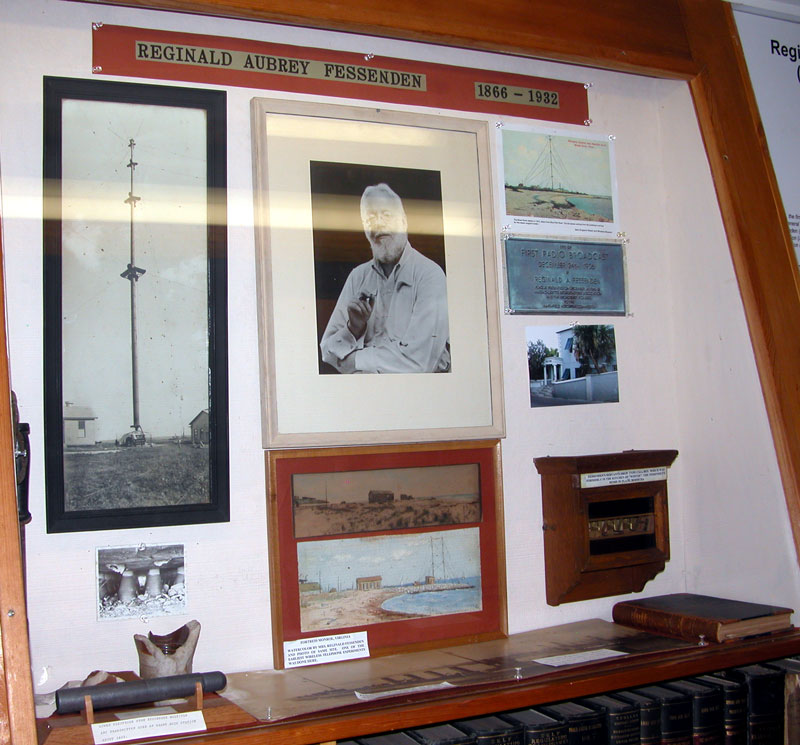He had a wealth of patents also. I’m very fortunate in that…I’ve lost count of the number of times I’ve been to Bermuda…literally…and I got to know about Fessenden’s in-laws. He married a Bermudian lady, and his house is this one right here, which still stands in Bermuda.
Fred – “Was he an academic?.. Or a business man?”
Well, he was nobody’s fool, but he didn’t have a lot of college degrees behind him. He grew up in a little English enclave in Quebec. His father and grandfather were Church of England ministers. He put up this tower at Brant Rock, Massachusetts, which was designed out of smokestack sections, and it was just big enough so he could get his somewhat portly body up the inside. He had ladder rungs up inside…there was a trap door at the bottom…and he could climb up there.
Fred – “So that was a huge thing!”
Oh, well, you can see the scale of it there. Anyway, he put that up in 1906, and he is the guy that said spark is nonsense, we should go to continuous wave. He was way ahead of the world in this regard. And so he made continuous waves, mechanically, with high-speed alternators. They were dealing with frequencies that were well under a hundred kilocycles. And that’s why the size of the tower.
Anyway, on Christmas Eve, in 1906, he sang hymns and played musical instruments and so forth on a program from Brant Rock. Nobody expected to hear sound on the radio, you know, or the wireless as it would be, but a number of military ships and steamers reported that they heard his signals, and on Christmas Eve, he put on a program. I think they had a piano somebody played, and so forth, and they were going to repeat the performance. They built a duplicate station in Ardrossan, Scotland, in the wintertime up there. And tragically, a Scottish storm blew the tower down before they were able to complete the experiment, and they didn’t have the funds to replace the tower…they never did…it’s kind of sad…but a number of people in England did report that they heard the signal.
Fred – “This was in 1906?”
Yes, very early. Everything else was spark but this was continuous wave. He was ahead of his time.
This is what remains of the base of the tower today, and those are a couple of shards…insulators that supported the different layers…several layers of concrete about six-inches thick, separated by these porcelain insulators. It provided high-voltage separation.
Nancy and I, actually, on our honeymoon, went over to call at this house, and Fessenden’s wife’s sister was living there at the time and she was very gracious and invited us in and gave us a tour all over the house. Of course, Bermuda has a social strata in the people there, so they always have maids and house servants, and so forth. This is the call box so that you can push a button in and a flag would denote which room needs the help, you know, and the maid would come running to that room in this house.
Fred – “Well, here he styles himself, ‘Professor’, in his book there, see?”
Yes, well, he did teach in a few places when he was starting out. Anyway, he was very stuffed with his own importance, so people would put a moniker like “professor” in front, but it was a valid thing.
There is this tower in a post card, down at Brant Point, Mass, and you see the magnitude of it…oh, by the way, see the smokestack? They made their own electricity with a little power plant there…steam power…I don’t know if commercial electricity was available yet at that time out in that isolated area.
Fred – “Now here you’ve made a display with a picture of one of those rotary…”
He made this rotary gap…I’m not sure if that is correct. I-Triple-E (IEEE) prepared these posters… this was out at the Ford museum last I knew. And this is what this pedestal base looked like. All these ceramic bottles were in here, separating it. Good ol’ Fessenden.
Text from the transcript of a tour of New England Wireless & Steam Museum’s Wireless Building given by Robert W. Merriam on a winter day in 2012. Transcription by Craig H. Moody, K1CHM. Edited by Fred Jaggi.
